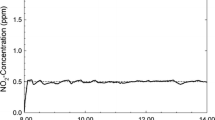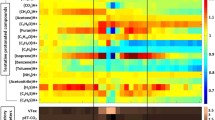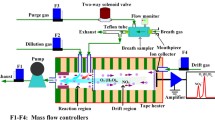Abstract
Endogenously produced nitric oxide (NO) is detectable in the exhaled air of resting humans, and the amount of exhaled NO increases during exercise. It is believed that NO is likely to have an important role in the normal physiological response to exercise. Despite accumulating evidence of exhaled NO during exercise, the effects and relevance of NO to exercise are not yet completely understood. Scientific debate surrounds the site of NO production and the stimuli for production. Resolution of these controversial issues will explain the significance of exhaled NO during exercise.
Similar content being viewed by others
References
Gustafsson LE, Leone AE, Persson MG, et al. Endogenous nitric oxide is present in the exhaled air of rabbits, guinea pigs and humans. Biochem Biophys Res Commun 1991; 181: 852–7
Maroun MJ, Mehta S, Turcotte R, et al. Effects of physical conditioning on endogenous nitric oxide output during exercise. J Appl Physiol 1995; 79: 1219–25
Phillips CR, Giraud GD, Holden WE. Exhaled nitric oxide during exercise: site of release and modulation by ventilation and blood flow. J Appl Physiol 1996; 80: 1865–71
Popescu LM, Foril CP, Hinescu M, et al. Nitroglycerin stimulates sarcolemmal Ca2+ extrusion ATPase of coronary smooth muscle cells. Biochem Pharmacol 1985; 34: 1875–9
Schultz KD, Schultz K, Schultz G. Sodium nitroprusside and other smooth muscle relaxants increase cGMP levels in rat ductus deferens. Nature 1977; 265: 750–1
Raeyrnaekers L, Hoffmann F, Casteels R. Cyclic GMP-dependent protein kinase phosphorylates phospholamba in isolated sarcoplasmic reticulum from cardiac and smooth muscle. Biochem J 1988; 252: 269–73
Twort CHC, Van Breemen C. cGMP-enhanced sequestration of Ca2+ by sarcoplasmic reticulum in vascular smooth muscle. Circ Res 1988; 62: 961–4
Furukawa KI, Ohshima N, Tawada-Tata Y, et al. Cyclic GMP stimulates Na+/Ca2+ exchange in vascular smooth muscle cells in primary culture. J Biol Chem 1991; 266: 12337–41
Leone AM, Gustafsson LE, Francis PL, et al. Nitric oxide is present in exhaled breath in humans: direct GC-MS confirmation. Biochem Biophys Res Commun 1994; 201: 883–7
Bauer JA, Wald JA, Doran S, et al. Endogenous nitric oxide in expired air: effects of acute exercise in humans. Life Sci 1994; 55: 1903–9
Iwamoto J, Pendergrast DR, Suzuki H, et al. Effect of graded exercise on nitric oxide in expired air in humans. Respir Physiol 1994; 97: 333–45
Chirpaz-Oddou MF, Favre-Juvin A, Flore P, et al. Nitric oxide response in exhaled air during an incremental exhaustive exercise. J Appl Physiol 1997; 82: 1311–8
Persson MG, Wiklund NP, Gustafsson LE. Endogenous nitric oxide in single exhalations and the change during exercise. Am Rev Respir Dis 1993; 148: 1210–4
Pogliaghi S, Krasney JA, Pendergast DR. Effect of gravity on lung exhaled nitric oxide at rest and during exercise. Respir Physiol 1997; 107: 157–64
Matsumoto A, Hirata Y, Momomura S, et al. Increased nitric oxide production during exercise. Lancet 1994; 343: 849–50
Trolin G, Anden T, Hedenstierna G. Nitric oxide (NO) in expired air at rest and during exercise. Acta Physiol Scand 1994; 151: 159–63
Schedin U, Roken BO, Nyman G, et al. Endogenous nitric oxide in the airways of different animal species. Acta Physiol Scand 1997; 41: 1133–41
Gustafsson LE. Exhaled nitric oxide production in the lung. In: Zapol WM, Bloch KD, editors. Nitric oxide and the lung. New York: Marcel Dekker, 1997: 185–201
Silkoff PE, McClean PA, Slutsky AS, et al. Marked flow-dependence of exhaled nitric oxide using a new technique to exclude nasal nitric oxide. Am J Respir Crit Care Med 1997; 155: 260–7
Hogman H, Stromberg S, Schedin U, et al. Nitric oxide from the human respiratory tract efficiently quantified by standardised single breath measurements. Acta Physiol Scand 1997; 159: 345–6
Kimberly B, Nejadnik B, Giraud GD, et al. Nasal contribution to exhaled nitric oxide at rest and during breathholding in humans. Am J Respir Crit Care Med 1996; 153: 829–36
Robbins RA, Floreani AA, Von Essen SG, et al. Measurement of exhaled nitric oxide by three different techniques. Am J Respir Crit Care Med 1996; 153: 1631–5
Schedin U, Frostell C, Persson MG, et al. Contribution from upper and lower airways to exhaled endogenous nitric oxide in humans. Acta Physiol Scand 1995; 39: 327–32
Lundberg JON, Rinder J, Weitzberg E, et al. Heavy physical exercise decreases nitric oxide levels in the nasal airways in humans. Acta Physiol Scand 1997; 159: 51–7
Rinder J. Sensory neuropeptides and nitric oxide in nasal vascular regulation. Acta Physiol Scand 1996; 157: 7–45
Falck B, Aust R, Svanholm H, et al. The effect of physical work on the mucosal blood flow and gas exchange in the human maxillary sinus. Rhinology 1989; 27: 241–50
Ohki M, Hasegawa M, Kurita N, et al. Effects of exercise on nasal blood flow. Acta Otolaryngol 1987; 104: 328–33
Kingwell BA, Sherrard B, Jennings GL, et al. Four weeks of cycle training increases basal production of nitric oxide in the forearm. Am J Physiol 1997; 272: H1070–7
Gilligan DM, Panza JA, Kilcoyne CM, et al. Contribution of endothelium-derived nitric oxide to exercise-induced vasodilation. Circulation 1994; 90: 2853–8
Sessa WC, Pritchard K, Seyedi N, et al. Chronic exercise in dogs increases coronary vascular nitric oxide production and endothelial cell nitric oxide gene expression. Circ Res 1994; 74: 349–53
Wang J, Wolin MS, Hintze TH. Chronic exercise enhances endothelium- mediated dilation of epicardial coronary artery in dogs. Circ Res 1993; 73: 829–38
Ambring A, Benthin G, Petersson AS, et al. Indirect evidence of increased expression of NO synthase in marathon runners, and upregulation of NO synthase activity during running [abstract]. Circulation 1994; 90: I137
Jungersten L, Ambring A, Wall B, et al. Both physical fitness and acute exercise regulate nitric oxide formation in healthy humans. J Appl Physiol 1997; 82: 760–4
Shen W, Zhang X, Zhao G, et al. Nitric oxide production and NO synthase gene expression contribute to vascular regulation during exercise. Med Sci Sports Exerc 1995; 27: 1125–34
Poveda JJ, Riestra A, Salas E, et al. Contribution of nitric oxide to exercise-induced changes in healthy volunteers: effects of acute exercise and long-term physical training. Eur J Clin Invest 1997; 27: 967–71
Alving K, Weitzberg E, Lundberg JM. Increased amount of nitric oxide in exhaled air of asthmatics. Eur Respir J 1993; 6: 1368–70
Byrnes CA, Dinarevic S, Busst C, et al. Is nitric oxide in exhaled air produced at airway or alveolar level? Eur Respir J 1997; 10: 1021–5
Shaul PW, North AJ, Wu LC, et al. Endothelial nitric oxide synthase is expressed in cultured bronchiolar epithelium. J Clin Invest 1994; 94: 2231–6
Borland C, Cox Y, Higenbottam T. Measurement of exhaled nitric oxide in man. Thorax 1993; 48: 1160–2
Kharitonov SA, Chung KF, Evans D, et al. Increased exhaled nitric oxide in asthma is mainly derived from the lower respiratory tract. Am J Respir Crit Care Med 1996; 153: 1773–80
Cremona G, Higenbottam T, Takao M, et al. Exhaled nitric oxide in isolated pig lungs. J Appl Physiol 1995; 78: 59–63
Kobzik L, Bredt DS, Lowenstein CJ, et al. Nitric oxide synthase in human and rat lung: immunocytochemical and histochemical localization. Am J Respir Cell Mol Biol 1993; 9: 371–7
Stromberg S, Lormqvist PA, Persson MG, et al. Lung distension and carbon dioxide affect pulmonary nitric oxide formation in the anaesthetized rabbit. Acta Physiol Scand 1997; 159: 59–67
Persson MG, Gustafsson LE, Wiklund NP, et al. Endogenous nitric oxide as probable modulator of pulmonary circulation and hypoxic pressor response in vivo. Acta Physiol Scand 1990; 140: 449–59
Pohl U, Holtz J, Busse R, et al. Crucial role of endothelium in the vasodilator response to increased flow in vivo. Hypertension 1986; 8: 27–44
Rubanyi GM, Romero JC, Vanhoutte PM. Flow-induced release of endothelium-derived relaxing factor. Am J Physiol 1996; 250: H1145–9
Melkumyants AM, Balashov SA, Khayutin VM. Control of arterial lumen by shear stress on endothelium. News Physiol Sci 1995; 10: 204–10
Wilson JR, Kapoor S. Contribution of endothelium-derived relaxing factor to exercise-induced vasodilation in humans. J Appl Physiol 1993; 75: 2740–4
Sumino H, Sato K, Sakamaki T, et al. Decreased basal production of nitric oxide in patients with heart disease. Chest 1998; 113: 317–22
Persson MG, Lonnqvist PA, Gustafsson LE. Positive end-expiratory pressure ventilation elicits increases in endogenously formed nitric oxide as detected in the air exhaled by rabbits. Anesthesiology 1995; 82: 969–74
Pison U, Lopez FA, Heidelmeyer CF, et al. Inhaled nitric oxide reverses hypoxic pulmonary vasoconstriction without impairing gas exchange. J Appl Physiol 1993; 74: 1287–92
Frostell C, Fratacci MD, Wain JC, et al. Inhaled nitric oxide; a selective pulmonary vasodilator reversing hypoxic vasoconstriction. Circulation 1991; 83: 2038–47
Putensen C, Rasanen J, Lopez FA. Improvement in VA/Q distributions during inhalation of nitric oxide in pigs with methacholine- induced bronchoconstriction. Am J Respir Crit Care Med 1995; 151: 116–22
Roger N, Barbera JA, Roca J, et al. Nitric oxide inhalation during exercise in chronic obstructive pulmonary disease. Am J Respir Crit Care Med 1997; 156: 800–6
Fagan KA, Sato K, Tyler RC, et al. Endothelial nitric oxide synthase (eNOS) knock-out mice develop pulmonary hypertension [abstract]. Circulation 1997; 96: I61
Stamler JS, Loh E, Roddy MA, et al. Nitric oxide regulates basal systemic and pulmonary vascular resistance in healthy humans. Circulation 1994; 89: 2035–40
Kharitonov SA, Yates D, Robbins RA, et al. Increased nitric oxide in exhaled air of asthmatic patients. Lancet 1994; 343: 133–5
Persson MG, Zetterstrom O, Argenius V, et al. Single-breath oxide measurements in asthmatic patients and smokers. Lancet 1994; 343: 146–7
Hamid Q, Springall DR, Riveros-Moreno V, et al. Induction of nitric oxide synthase in asthma. Lancet 1993; 342: 1510–3
Barnes PJ, Kharitonov SA. Exhaled nitric oxide: a new lung function test. Thorax 1996; 51: 233–7
Dempsey JA, Hanson PG, Henderson KS. Exercise-induced arterial hypoxemia in healthy human subjects at sea level. J Physiol (Lond) 1984; 355: 161–75
Hopkins SR, McKenzie DC. Hypoxic ventilatory response and arterial desaturation during heavy work. J Appl Physiol 1989; 67: 1119–24
Hopkins SR, McKenzie DC, Schoene RB, et al. Pulmonary gas exchange during exercise in athletes. I: ventilation-perfusion mismatch and diffusion limitation. J Appl Physiol 1994; 77: 912–7
Author information
Authors and Affiliations
Corresponding author
Rights and permissions
About this article
Cite this article
Sheel, A.W., Road, J. & McKenzie, D.C. Exhaled Nitric Oxide During Exercise. Sports Med 28, 83–90 (1999). https://doi.org/10.2165/00007256-199928020-00003
Published:
Issue Date:
DOI: https://doi.org/10.2165/00007256-199928020-00003




